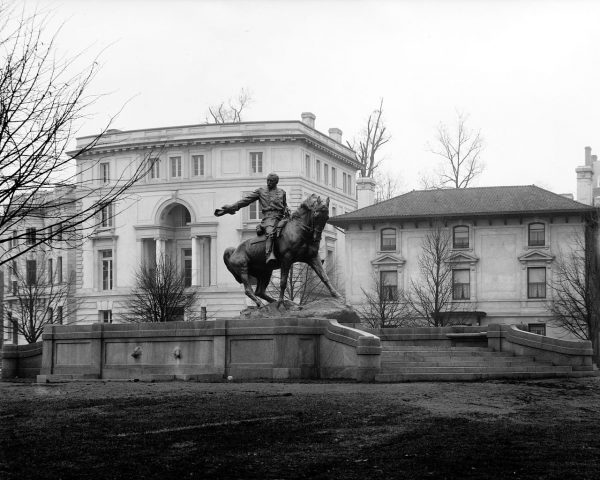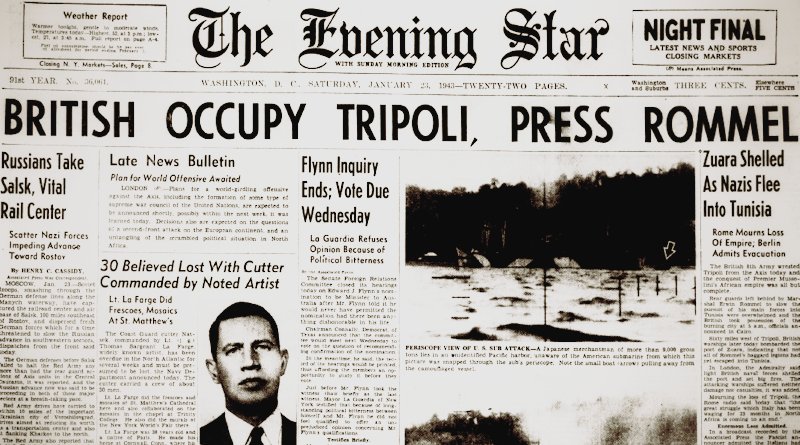World War II Chronicle: January 23, 1943
Click here for TODAY’S NEWSPAPER
Eddie Rickenbacker’s copilot continues his story on page two… On the same page Lt. Col. Lewis B. “Chesty” Puller is again featured explaining the situation in Guadalcanal… George Fielding Eliot column on page six… Sports on page nine
Sports on page 19, which reports that the Yankees have traded two minor leaguers to the Phillies along with $10,000 to acquire first baseman Nick Etten. Philadelphia returns them to the Yankees, who instead complete the trade with Tom Padden — a catcher who hasn’t been in the big leagues since 1937 — and rookie lefthanded pitcher Al Gerheauser, who will start 31 games this year for the Phillies…
The statue of Union general Philip Henry Sheridan is pictured on page 10. When the statue was dedicated in 1908, the ceremony was attended by many Civil War veterans and Pres. Theodore Roosevelt. Interestingly, the Civil War was just as recent to the person reading today’s paper as World War II is to us. The surrounding buildings are foreign embassies. You can get a good look at the neighborhood on Google Earth.

Roving Reporter by Ernie Pyle
A FORWARD AIR DROME IN FRENCH NORTH AFRICA — You read the official communiques a few days ago about a devastating raid by our Flying Fortresses on a huge German bomber airdrome near Tripoli. What you didn’t read, at least in any detail, is the story contained in these next three columns.
It was late afternoon at our desert airdrome. The sun was lazy, the air was warm, and a faint haze of propeller dust hung over the field, giving it softness.
It was time for the planes to start coming back from their mission, and one by one they did come — big Flying Fortresses and fiery little Lightnings. Nobody paid a great deal of attention, for this returning is a daily routine thing.
Finally they were all in — all, that is, except one. Operations reported a Fortress missing. Returning pilots said it had lagged behind and lost altitude just after leaving the target. The last report said the Fortress couldn’t stay in the air more than five minutes. Hours had passed since then. So it was gone.
Ten men were in that plane. The day’s accomplishments had been great, but the thought of 10 lost friends cast a pall over people.
We had already seen death that afternoon. For one of the returning Fortresses had released a red flare over the field, and I had stood with others beneath the great plane as they handed its dead pilot, head downward, through the escape hatch onto a stretcher.
The faces of his crew were grave, and nobody talked very loud. One man clutched a leather cap with blood on it. The pilot’s hands were very white.
Everybody knew the pilot. He was so young, a couple of hours ago. The war came inside us then, and we felt it deeply.
Half a dozen of us went to the high control tower. We go there every evening, for two things — to watch the sunset, and to get a report on the progress of the German bombers that frequently come just after dusk to blast our airdrome.
The sunsets here in the desert are truly things with a soul. The violence of their color is incredible. They splatter the sky and the clouds with a surging beauty. The mountains stand dark against the horizon, and palm trees silhouette themselves dramatically against the fiery west.
As we stood on the tower looking down over this powerful scene the day began folding itself up. Fighter planes, which patrol the field all day, were coming in. All the soldiers in the tent camps had finished supper. That noiseless peace that sometimes comes just before dusk hung over the airdrome. Men talked in low tones about the dead pilot and the lost Fortress.
We thought we would wait a few minutes more to see if the Germans were coming tonight.
And then an electric thing happened. Far off in the dusk a red flare shot into the sky. It made an arc against the dark background of the mountains and fell to the earth.
It couldn’t be anything else. It had to be. The ten dead men were coming home!
“Where’s the flare gun? Gimme a green flare!” yelled an officer.
He ran to the edge of the tower, shouted “Look out below!” and fired a green rocket into the air.
Then we saw the plane — just a tiny black speck. It seemed almost on the ground, it was so low, and in the first glance we could sense that it was barely moving, barely staying in the air. Crippled and alone, two hours behind all the rest, it was dragging itself home.
I am a layman, and no longer of the fraternity that flies, but I can feel. And at that moment I felt something close to human love for that faithful, battered machine, that far dark speck struggling toward us with such pathetic slowness.
All of us stood tense, hardly remembering anyone else was there. With our nervous systems we seemed to pull the plane toward us. I suspect a photograph would have shown us all leaning slightly to the left.
Not one of us though the plane would ever make the field, but on it came — so slowly that it was cruel to watch.
It reached the far end of the airdrome, still holding its pathetic little altitude. It skimmed over the tops of parked planes, and kept on actually reaching out — it seemed to us — for the runway. A few hundred yards more now. Could it? Would it? Was it truly possible?
They cleared the last plane, and they were over the runway. They settled slowly. The wheels touched softly. And as the plane rolled on down the runway the thousands of men around that vast field suddenly realized that they were weak and they could hear their hearts pounding.
The last of the sunset died, and the sky turned into blackness, which would help the Germans if they came on schedule with their bombs. But nobody cared. Our 10 dead men were miraculously back from the grave.
Monday: How They DID It.
Evening star. (Washington, D.C.), 23 January 1943. Chronicling America: Historic American Newspapers. Lib. of Congress.
https://chroniclingamerica.loc.gov/lccn/sn83045462/1943-01-23/ed-1/
